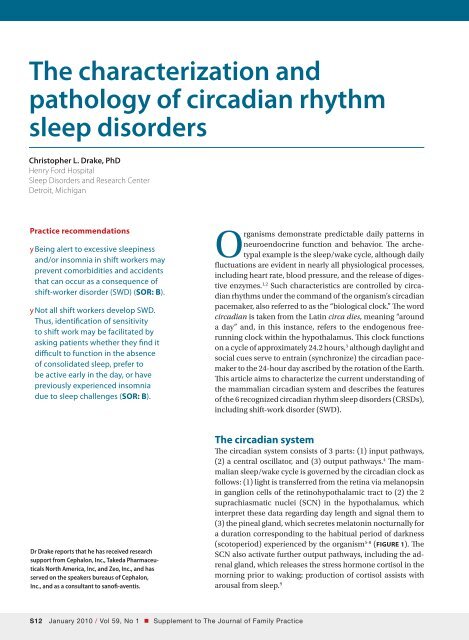Shift-work disorder - myCME.com
Shift-work disorder - myCME.com
Shift-work disorder - myCME.com
You also want an ePaper? Increase the reach of your titles
YUMPU automatically turns print PDFs into web optimized ePapers that Google loves.
The characterization and<br />
pathology of circadian rhythm<br />
sleep <strong>disorder</strong>s<br />
Christopher L. Drake, PhD<br />
Henry Ford Hospital<br />
Sleep Disorders and Research Center<br />
Detroit, Michigan<br />
Practice re<strong>com</strong>mendations<br />
y Being alert to excessive sleepiness<br />
and/or insomnia in shift <strong>work</strong>ers may<br />
prevent <strong>com</strong>orbidities and accidents<br />
that can occur as a consequence of<br />
shift-<strong>work</strong>er <strong>disorder</strong> (SWD) (SOR: B).<br />
y Not all shift <strong>work</strong>ers develop SWD.<br />
Thus, identification of sensitivity<br />
to shift <strong>work</strong> may be facilitated by<br />
asking patients whether they find it<br />
difficult to function in the absence<br />
of consolidated sleep, prefer to<br />
be active early in the day, or have<br />
previously experienced insomnia<br />
due to sleep challenges (SOR: B).<br />
Organisms demonstrate predictable daily patterns in<br />
neuroendocrine function and behavior. The archetypal<br />
example is the sleep/wake cycle, although daily<br />
fluctuations are evident in nearly all physiological processes,<br />
including heart rate, blood pressure, and the release of digestive<br />
enzymes. 1,2 Such characteristics are controlled by circadian<br />
rhythms under the <strong>com</strong>mand of the organism’s circadian<br />
pacemaker, also referred to as the “biological clock.” The word<br />
circadian is taken from the Latin circa dies, meaning “around<br />
a day” and, in this instance, refers to the endogenous freerunning<br />
clock within the hypothalamus. This clock functions<br />
on a cycle of approximately 24.2 hours, 3 although daylight and<br />
social cues serve to entrain (synchronize) the circadian pacemaker<br />
to the 24-hour day ascribed by the rotation of the Earth.<br />
This article aims to characterize the current understanding of<br />
the mammalian circadian system and describes the features<br />
of the 6 recognized circadian rhythm sleep <strong>disorder</strong>s (CRSDs),<br />
including shift-<strong>work</strong> <strong>disorder</strong> (SWD).<br />
Dr Drake reports that he has received research<br />
support from Cephalon, Inc., Takeda Pharmaceuticals<br />
North America, Inc, and Zeo, Inc., and has<br />
served on the speakers bureaus of Cephalon,<br />
Inc., and as a consultant to sanofi-aventis.<br />
The circadian system<br />
The circadian system consists of 3 parts: (1) input pathways,<br />
(2) a central oscillator, and (3) output pathways. 4 The mammalian<br />
sleep/wake cycle is governed by the circadian clock as<br />
follows: (1) light is transferred from the retina via melanopsin<br />
in ganglion cells of the retinohypothalamic tract to (2) the 2<br />
suprachiasmatic nuclei (SCN) in the hypothalamus, which<br />
interpret these data regarding day length and signal them to<br />
(3) the pineal gland, which secretes melatonin nocturnally for<br />
a duration corresponding to the habitual period of darkness<br />
(scotoperiod) experienced by the organism 5-8 (FIGURE 1). The<br />
SCN also activate further output pathways, including the adrenal<br />
gland, which releases the stress hormone cortisol in the<br />
morning prior to waking; production of cortisol assists with<br />
arousal from sleep. 9<br />
S12 January 2010 / Vol 59, No 1 • Supplement to The Journal of Family Practice
















